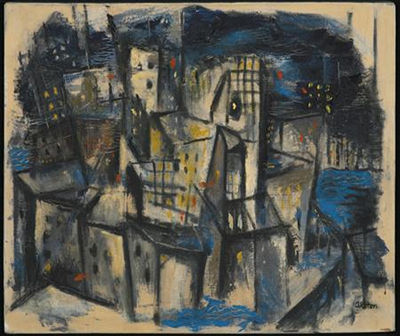
Born in Charlotte, North Carolina in 1907 Alston’s interest in art began early. He received the art award in Grammar School and was actively involved in the arts throughout High School. In 1925 he enrolled at Columbia University in New York City where he studied art and art history. Upon receiving his undergraduate degree, he was awarded the Arthur Wesley Dow Fellowship, enabling him to earn his Masters Degree in Fine Arts at Columbia’s Teachers College.
He began his career as a commercial artist working on book jackets, record covers and magazines. Alston was a successful commercial artist, working for leading magazines such as Fortune, Collier’s, Mademoiselle and Men’s Wear. However, commercial art demanded compromises and restrictions on his style, eventually driving Alston out of the field in pursuit of a more personal form of artistic expression; stating, “I felt that I could do good painting and that I was selling myself cheap.” In 1950 the Metropolitan Museum of Art held its first exhibition of contemporary art. Along with nearly 4,000 other artists, Alston entered a painting for competition and was one of the few chosen for purchase. He considered this moment “an exoneration or certification . . . the thing that made me feel comfortable with my decision.”
In that same year the Art Students League selected Alston as their first African American instructor. By the mid-1950s the Metropolitan Museum, the Whitney Museum of American Art, the Butler Institute of Art and IBM housed his works in their permanent collections. During this period he also completed murals for the Museum of Natural History and the Abraham Lincoln High School in Brooklyn. In 1969 Alston was appointed a “painter member” of the New York City Art Commission, which approved all designs for city buildings and works of art on city property. He was the first African American to achieve this post.
Alston’s artistic style defies simple categorization and definition. His works range from detailed drawings concerned with realism, depth and modeling to extreme abstraction concerned with simplicity, flatness and pure expression. His art always remained to him an outlet for personal expression and growth, unbound by the restrictions of one particular genera. To Alston, “The whole creative thing is one of exploration of new or different areas,” and in “developing or exploring an idea until you’ve gotten out of it everything you can, and beyond that, looking for unexplored areas.”
The diversity of Alston’s style reflects influences ranging from Egyptian and Oceanic art to more contemporary artistic styles like Cubism and Abstract Expressionism. However, his figures characteristically maintain a sculpture like quality derived from his earlier studies in African sculpture. His subjects, however, were derived mainly from the experiences of his life and time. As such they deal with the toils and triumphs of African Americans in the decades of the 50’s, 60’s and 70’s. Alston states, “As an artist . . . I am intensely interested in probing, exploring the problems of color, space and form, which challenge all contemporary painters. However, as a black American . . . I cannot but be sensitive and responsive in my painting to the injustice, the indignity, and the hypocrisy suffered by black citizens.”
On April 27, 1977 Charles Alston died of cancer. His body of work seeks the universal artistic goal of aesthetically depicting the truth within the prism of his life experiences. In his words he tells us, “Art is the pursuit of truth as an artist perceives it. It can also be a powerful and effective weapon in the struggle for human decency.”
